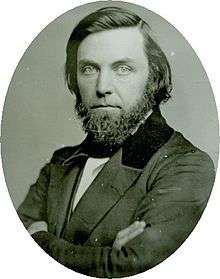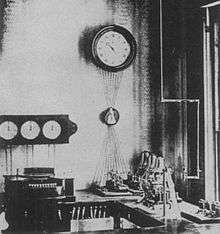William Francis Channing

William Francis Channing (February 22, 1820 – March 20, 1901) was an American activist, electrical researcher, scientist, physician, and inventor. He invented the first citywide electric fire alarm system. Channing worked with Alexander Graham Bell in developing the telephone.
Early life
Channing was born in Boston on February 22, 1820. He was the son of William Ellery Channing, the Unitarian preacher, and Ruth Gibbs.[1] He was cousin of William Henry Channing, Unitarian clergyman, writer and philosopher.[2][3]
Mid life
Channing began to study at Harvard and graduated in 1839.[2] He decided to follow medicine instead and went to the University of Pennsylvania.[4] Channing did a thesis on the "Application of Chemistry to Physiology" in 1844 for his doctorate and received a degree in medicine.[1]
Channing was an assistant on the first geological survey of New Hampshire during 1841–42. He was associated with Henry Ingersoll Bowditch in the editorship of the Latimer Journal in Boston from 1842 to 1843.[5] He also served in the capacity as an assistant on the geological survey of the copper region of Lake Superior in 1847.[6]
Fire alarm system

Samuel Morse invented the telegraph in 1837 and commercial usage was begun in 1844. Channing spun off this technology to create a citywide fire alarm system. With the assistance of Professor Farmer, an electrical engineer, they developed a fire-alarm telegraph. They talked the officials of Boston into financing the construction of a city-wide fire alarm system. The first central office was located at 21 Court Square. The city owned the building. The system began testing on 28 April 1852. The first fire alert was received the very next night. Channing and Moses obtained a patent on this electrical telegraph system on 19 May 1857. It was US Patent #17,355 and known as the American fire-alarm telegraph or the "city system."[7]
The object of the fire-alarm system was to give a fast alarm in a city in case of fire. It first gave a signal to the central station of a fire from a local neighborhood. The city-wide system was to provide a signaling station near all houses. The central station then had a bell-tower to give an alert by means of a bell that could be heard by many. The central office knew where the local fire was and the public could respond accordingly.[8]
Channing being a medical physician looked at electric wires and the human nervous system as resembling each other. He looked at this first fire-alarm system as merely an application of the fundamentals of self-preservation that is found throughout nature.[9]
Science research and patents

Channing contributed to the American Journal of Science and published with Prof. John Bacon, Jr., "Davis's Manual of Magnetism," 1841; "Notes on the Medical Application of Electricity," 1849; and "The American Fire-Alarm Telegraph," 1855.[10]
Channing with Moses G. Farmer received a patent 19 May 1857 for the first citywide electric fire alarm system in the United States.[11][12] He also patented a ship railway for the inter-oceanic transit of ships in 1865.[13]
- Patents
Channing moved to Providence, Rhode Island, in 1861 and worked with Bell in making a commercially practicable telephone.[14] He worked with Professor John Peirce of Brown University at Providence with experimental telephone ideas that included a mouthpiece.[15][16] Channing also came up with the innovation of a hand-held telephone.[17] Many of these experimental electromagnetic telephone ideas were conveyed to Bell in 1876.[18] This below is a letter of 30 July 1877 held at the Library of Congress concerning the electromagnetic telephone idea Channing had with Professor Peirce, describing it to Alexander Graham Bell.
- widths="180px"




Family
Channing first married a Miss Susan Burdick and they had a daughter, Eva, who grew to adulthood. They had a one son, Allston, who died while a child. Channing later married a Miss Mary J. Tarr from Boston in 1859. They had three children, Mary, Grace, and Harold.[14]
Death
Channing died in Boston on March 20, 1901.[14]
Works
- 1842 – Davis's Manual of Magnetism
- 1851 – Communication from Dr. Wm. F. Channing respecting a System of Fire Alarms
- 1852 – Notes on the Medical Application of Electricity
- 1865 – The Medical application of electricity
- 1871 – Record of Proceedings Before the U.S. Patent Office:
- 1876 – Popular Science Monthly/Volume 9/October 1876/Organized Homesteads and Households
- 1883 – Popular Science Monthly/Volume 23/August 1883/The Telephone, with a Sketch of its Inventor, Philipp Reis
References
- 1 2 Kelly 1920, p. 206.
- 1 2 Medical News 1901, p. 514.
- ↑ Overmire, Laurence (2015-02-15). "The Ancestry of Overmire Tifft Richardson Bradford Reed". RootsWeb. Ancestry.com. Retrieved October 9, 2015.
- ↑ Johnson & Brown 1904, p. 138.
- ↑ Iversen 1977, p. 199.
- ↑ Appleton 1902, p. 416.
- ↑ "World's First Fire Alarm System". ComputerImages. Retrieved October 9, 2015.
- ↑ Rogers 2010, pp. 73,74.
- ↑ Sandler, S. Gerald (September 6, 1962). "William Francis Channing (1820–1901)". Massachusetts Medical Society. Retrieved October 9, 2015.
- ↑ Wilson & Fiske 1887, p. 578.
- ↑ Kane 1997, p. 272.
- ↑ "William Ellery Channing". Dictionary of Unitarian and Universalist Biography. Retrieved October 9, 2015.
His son, William Francis Channing, designed Boston's citywide fire alarm system, the nation's first.
- ↑ Chamberlain 1902, p. 60.
- 1 2 3 Alumni Register 1900, p. 242.
- ↑ Miles & Gould 1994, pp. 215–220.
- ↑ Christopher, Martin (1944). "Alexander Graham Bell and Rhode Island". The Old Stone Bank History of Rhode Island, Vol. IV, pages 214–216. Providence Institution for Savings. Retrieved October 11, 2015.
- ↑ Bruce 1990, p. 225.
- ↑ PRESCOTT, GEORGE B. (1878), THE SPEAKING TELEPHONE, TALKING PHONOGRAPH AND OTHER NOVELTIES. (PDF), Library of Congress: University of Virginia, retrieved October 10, 2015
Sources
- Alumni Register (1900). Alumni Register. General Alumni Society University of Pennsylvania.
Channing in 1861 moved to Providence, and associated himself with Prof. Graham Bell and Dr. E. W. Blake in the work of making a telephone which would be commercially practicable.
- Appleton, D (1902). Appletons' Annual Cyclopaedia and Register of Important Events. D. Appleton & Company.
- Bruce, Robert V. (1990). Bell: Alexander Graham Bell and the Conquest of Solitude. Cornell University Press. ISBN 0-8014-9691-8.
- Chamberlain, Joshua Lawrence (1902). University of Pennsylvania: Its History, Influence, Equipment and Characteristics; with Biographical Sketches and Portraits of Founders, Benefactors, Officers and Alumni. R. Herndon Company.
- Iversen, Nick (January 1977). Record makers and record breakers. Jonathan David Publishers. ISBN 978-0-8246-0208-6.
- Johnson, Rossiter; Brown, John Howard (1904). William Francis Channing. The Twentieth Century Biographical Dictionary of Notable Americans ... Biographical Society.
- Kane, Joseph Nathan (1997). Famous First Facts, Fifth Edition. The H. W. Wilson Company. ISBN 0-8242-0930-3.
The first fire alarm system operated by electricity was invented by William Francis Channing of Boston, MA, and Moses Gerrish Farmer of Salem, MA, who on May 19, 1857, received a patent for “a magnetic electric fire-alarm.” The first city to adopt this system was Boston, which in June 1851 voted $10,000 to test the device.
- Kelly, Howard Atwood (1920). A Cyclopedia of American Medical Biography: Comprising the Lives of Eminent Deceased Physicians and Surgeons from 1610 to 1910. W.B. Saunders Company.
- Medical News (1901). Medical News. Henry C. Lea's Son & Company.
- Miles, Wyndham D.; Gould, Robert F. (1994). American chemists and chemical engineers. American Chemical Society. ISBN 978-0-9640255-0-9.
- Rogers, Dave (6 January 2010). Inventions and Their Inventors. M-Y Books Distribution. ISBN 978-1-906986-58-2.
- Wilson, James Grant; Fiske, John (1887). William Francis Channing. Appletons' Cyclopaedia of American Biography. D. Appleton.
External links
| Wikimedia Commons has media related to William Francis Channing. |
- Works by or about William Francis Channing at Internet Archive
- Find A Grave
- William F. Channing Papers, 1851–1898
- Harvard University Library Channing family papers